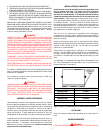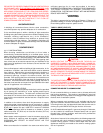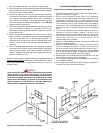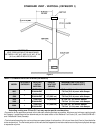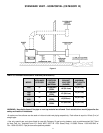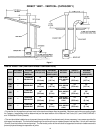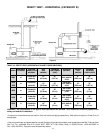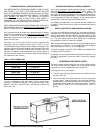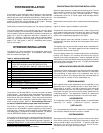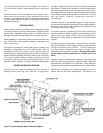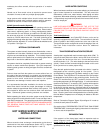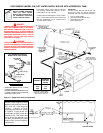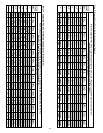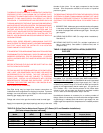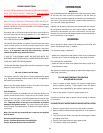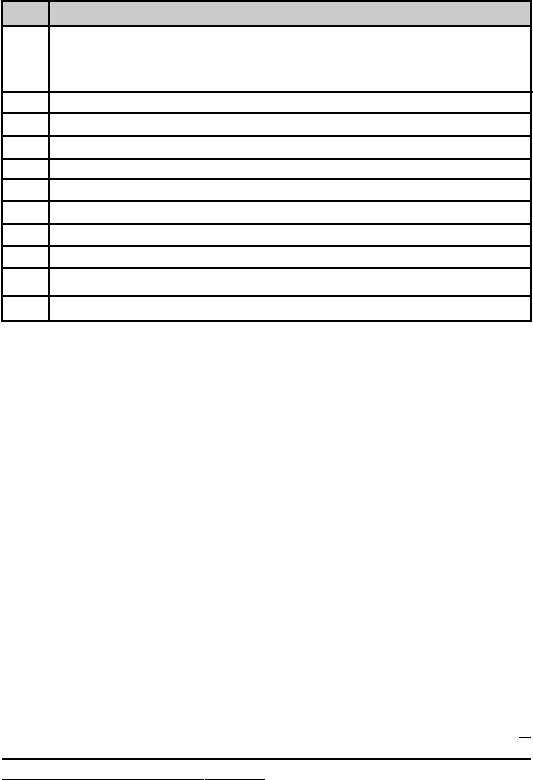
15
CONVENTIONAL SPACE HEATING INSTALLATION
Modern fin type boilers are exceptionally fast heating units. The low
water volumes in relation to firing rates require special attention to
water flow rates for smooth, efficient operation. These
considerations for the A. O. Smith copper heat exchanger boilers
are covered below.
Refer to table 4 showing flow rate vs. pressure drop and temperature
rise.
Figure 10 shows a typical installation of the boiler.
A system with several flow controlled zones, or with a 3-way mixing
valve system could present a flow rate to the boiler of less than
required for a maximum of 50°F (28°C)
temperature rise. Design
system with compensating bypasses to the boiler.
A system bypass should be installed as shown in figure 10 to
prevent boiler circulation starvation when the system zones call for
reduced flow.
This bypass may also be used with multiple boilers manifolded for
reverse-return flow. The system bypass would be installed from
boiler outlet to suction side of pump.
The boiler piping system of a hot water heating boiler connected to
heating coils located in air handling units where they may be
exposed to circulating refrigerated air, must be equipped with flow
control valves or other automatic means to prevent gravity circulation
of the boiler water during the cooling cycle. It is highly recommended
that the piping be insulated.
INSTALLATION AS BOILER REPLACEMENT
Installation as boiler replacement on an old system with large water
volume may result in condensation within the boiler on cold starts.
This condensing of water vapor in the combustion area can be
prevented if a portion of the system water flow is diverted past the
boiler to cause an increase in boiler temperature rise.
BYPASS BALANCING
With systems where water temperature can be expected to drop
appreciably due to long standby periods, or heavy draw down, a
bypass pipe of at least 1" size with a balancing cock should be
installed between the boiler inlet and outlet (see figure 10). When
the system first starts, the valve should be slowly opened until the
condensing ceases. This adjustment remains at a permanent
setting to establish required temperature rise across the boiler.
AIR SEPARATOR
An air separator as shown in the piping diagram is reccommended
especially for modern commercial hydronic systems.
VENT VALVES
It is recommended that automatic, loose key or screwdriver type
vent valves be installed at each convector or radiator.
SYSTEM HEADERS
Split systems with individual supply and return lines from the boiler
room should normally have this piping connected to supply and
return manifold headers near the boiler. To achieve good water
distribution with minimum pressure drop for several circuits,
manifolds should be larger than system loops.
SYSTEM INSTALLATION
GENERAL
If the system is to be filled with water for testing or other purposes
during cold weather and before actual operation, care must be
taken to prevent a down draft entering the boiler or freezing air from
contacting the system. Failure to do so may cause the water in the
system to freeze with resulting damage to the system. Damage
due to freezing is not covered by the warranty.
Good practice requires that all piping, etc., be properly supported.
The boilers described in this manual may be used for space
(hydronic) heating or for the heating of potable water. If the heater
is to be used for hydronic space heating, follow the instructions on
pages 15-17 given for equipment required for installation as in
Figure 10. However, if units are to be used for heating potable
water, the information describing specific systems is found on
pages 17-19. See figures 11 and 13. Installations must comply
with all local codes.
HYDRONIC INSTALLATION
The following is a brief description of the equipment required for
installations noted in this manual. All installations must comply
with local codes (see figure 10).
Table 12: INSTALLATION ITEMS
NO. SUGGESTED ITEMS FOR INSTALLATION
1. PAIR OF SHORT PIPE NIPPLES, PAIR OF BOILER
LOOP TEES AND BALL VALVE BETWEEN SYSTEM
SUPPLY AND RETURN - ONE SET PER EACH BOILER
2. BOILER PIPE LOOP (See Sizing Data Table 4.)
3. BOILER CIRCULATING PUMP (See Sizing Data Table 4.)
4. THERMOMETER
5. PRESSURE GAUGE
6. LOW WATER CUTOFF (If Required By Local Code.)
7. SAFETY FLOW SWITCH (Factory-Installed)
8. RELIEF VALVE (Factory-Installed)
9. BOILER INLET - OUTLET
10. SYSTEM SUPPLY TEMPERATURE THERMOMETER
11. DRAIN or BLOW-DOWN VALVE
WATER SUPPLY LINE
These boilers can be used ONLY in a forced circulation hot water
heating system. The pump must be interlocked with the boiler to
prevent boiler operation without water circulation. See maximum
and minimum flow rate information. Since most forced circulation
systems will be of the closed type, install the water supply line as
shown on piping diagram, figure 10. Severe damage will occur if
the boiler is operated without proper water flow circulation.
Fast filling of large pipe, old radiator installations (where high
pressures are not available) requires bypassing of the pressure
reducing valve. Generally, pressure purging is not possible with a
well pump system. High point air venting is essential. For details,
refer to OPERATION section of this manual on page 22.
If the system is of the open type, a pressure reducing valve will not
be required as the water supply to the system will be controlled by
a manually operated valve. An overhead surge tank is required.
A
MINIMUM PRESSURE OF 15 PSI (100 kPa) MUST BE MAINTAINED
ON THE BOILER AT ALL TIMES to avoid potential damage to the
boiler that may not be covered by the warranty.



